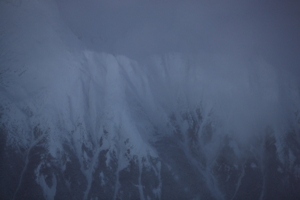Dec 20 2013
Northrop Grumman Corporation, the NASA Dryden Flight Research Center and a team of international science organizations successfully flew a Northrop Grumman-produced NASA Global Hawk unmanned aircraft system through Canadian airspace as part of a mission to collect environmental data in the Canadian Arctic.
 Image of a snow covered mountain taken from a high resolution camera on the NASA Global Hawk during a nighttime flight over the Canadian Arctic. These images will be used by American and Canadian scientists to study environmental changes in the Arctic.
Image of a snow covered mountain taken from a high resolution camera on the NASA Global Hawk during a nighttime flight over the Canadian Arctic. These images will be used by American and Canadian scientists to study environmental changes in the Arctic.
The Global Hawk was equipped with an Uninhabited Aerial Vehicle Synthetic Aperture Radar (UAVSAR) as well as a high resolution camera to conduct ground mapping and visual observation of Arctic ice caps during the approximately 21-hour flight. Information collected during this flight will be used by American and Canadian scientists to study changes in topography and Arctic ice caps.
"Flying high and long missions with advanced scientific equipment over the Arctic provides scientists with real data to better understand the changes that are affecting our world," said Janis Pamiljans, Northrop Grumman's sector vice president and general manager of unmanned systems. "The high-altitude, long-endurance NASA Global Hawk is one of the best tools researchers have to study weather phenomena."
This flight marks the first time the NASA Global Hawk has flown through Canadian civil airspace. Global Hawk's high-altitude, long-endurance capabilities enabled the aircraft to depart from NASA Dryden, based at Edwards Air Force Base, Calif., and fly over several predetermined key areas in the Arctic before returning to NASA Dryden.
Northrop Grumman, NASA Dryden, NASA Goddard Space Flight Center, NASA Jet Propulsion Laboratory, National Oceanic and Atmospheric Administration, and Canadian science counterparts worked together to enable this mission. NASA Global Hawks have already been used for a wide range of environmental missions, including collecting atmospheric data in support of the Airborne Tropical TRopopause EXperiment and deployment over the Atlantic Ocean to study hurricane formation and intensity change during the Hurricane and Severe Storm Sentinel missions.
The flight over the Canadian Arctic comes after the recent five-year renewal of the Space Act Agreement, a partnership between Northrop Grumman and NASA that allows sharing of NASA Global Hawks for science missions and flight demonstrations. The initial Space Act Agreement, signed in 2008, returned two preproduction Global Hawk aircraft to flight status. A permanent Global Hawk ground control station was built at NASA Dryden.
Northrop Grumman is a leading global security company providing innovative systems, products and solutions in unmanned systems, cyber, C4ISR, and logistics and modernization to government and commercial customers worldwide. Please visit www.northropgrumman.com for more information.